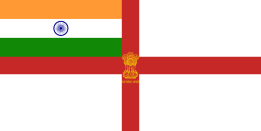Godavari-class frigate
_during_Malabar_2008.jpg) INS Godavari | |
| Class overview | |
|---|---|
| Name: | Godavari class |
| Builders: | Mazagon Dock Limited |
| Operators: |
|
| Preceded by: | Nilgiri class |
| Succeeded by: | Brahmaputra class |
| In commission: | 1983 – present |
| Planned: | 3 |
| Completed: | 3 |
| Active: | 2 |
| Retired: | 1 |
| General characteristics | |
| Type: | Guided-missile frigate |
| Displacement: |
|
| Length: | 126.4 m (414 ft 8 in) |
| Beam: | 14.5 m (47 ft 7 in) |
| Draught: | 4.5 m (14 ft 9 in) |
| Propulsion: | 2 × 30,000 hp (22,400 kW) steam turbines |
| Speed: | 27 knots (50 km/h) |
| Range: | 4,500 nmi (8,300 km) at 12 knots (22 km/h) |
| Complement: | 313 (incl. 40 officers, 13 air crew) |
| Sensors and processing systems: |
|
| Electronic warfare & decoys: |
|
| Armament: |
|
| Aircraft carried: | 2 × Sea King, HAL Dhruv or HAL Chetak helicopters |
The Godavari-class frigates (formerly Type 16 or Project 16 frigates) are guided-missile frigates of the Indian Navy. The Godavari class was the first significant indigenous warship design and development initiative of the Indian Navy. Its design is a modification of the Nilgiri class with a focus on indigenous content of 72%, a larger hull and updated armaments.
Two ships of this class currently serve in the Indian Navy. The class and the lead ship, INS Godavari are named after the Godavari River. Subsequent ships in the class, INS Ganga and INS Gomati also take their names from Indian rivers.
INS Gomati was the first Indian Navy vessel to have digital electronics in her combat data system. The ships combine Indian, Russian and Western weapons systems.[1]
History
The concept for the Godavari class originated from the lessons learnt in the Indo-Pakistan War of 1971. There was a need for a ship unique to Indian requirements, for deploying a hybrid of indigenously-designed, as well as Russian and European weapons systems.
One of the requirements was to deploy two Sea King helicopters from the ship. The Nilgiri-class vessels were too small for this requirement. The final design incorporated a larger hull in order to accommodate this.[2] INS Godavari was decommissioned on 23 December 2015, and her Barak 1 surface-to-air missile will be installed on the flagship INS Vikramaditya.[3][4]
Design
Although the Directorate of Marine Engineering suggested replacing steam propulsion with gas turbines, it was decided not to do so, since Bharat Heavy Electricals Limited and Hindustan Aeronautics Limited had made heavy investments in facilities and tooling for design of steam turbines and auxiliary systems.[2]
For armaments, the missile and gun package of the Soviet Nanuchka-class corvette was installed on the frigate.
The keel of the lead ship INS Godavari was laid in 1977 at Mazagon Dock Limited in Bombay. She was commissioned in December 1983.
Ships of the class
| Name | Pennant | Builder | Commissioned | Decommissioned | Homeport | Status |
|---|---|---|---|---|---|---|
| Godavari | F20 | Mazagon Dock Limited | 10 December 1983 | 23 December 2015 | Decommissioned | |
| Ganga | F22 | 30 December 1985 | Visakhapatnam | Scheduled to be decommissioned | ||
| Gomati | F21 | 16 April 1988 |
Upgrades
All three ships later underwent an extensive upgrade of weapons and sensors. These include the fitment of the Israeli Barak SAM system, and a new fire control system based on the EL/M-2221 STGR. The P-20 missiles have been retained for now.
Gallery
-
%2BINS_Brahmaputra_(F31)%2BINS_Beas_(F39).jpg)
INS Godavari with INS Brahmaputra and INS Beas trailing during exercises with the US Navy.
-
.jpg)
INS Ganga
References
- ↑ "Godavari (Type 16) Class". Bharat-Rakshak.com. Retrieved 26 September 2014.
- 1 2 "F 20 Godavari Class". globalsecurity.org. 9 July 2011. Retrieved 26 September 2014.
- ↑ "Vikramaditya to be fitted with Barak missiles". http://www.tribuneindia.com/. 21 Apr 2015. Retrieved 16 April 2015. External link in
|publisher=(help) - ↑ "INS Godavari sets sail into the sunset after three decades". Times of India. 21 December 2015. Retrieved 22 December 2015.
